display CADILLAC ESCALADE 2010 3.G Owners Manual
[x] Cancel search | Manufacturer: CADILLAC, Model Year: 2010, Model line: ESCALADE, Model: CADILLAC ESCALADE 2010 3.GPages: 616, PDF Size: 39.41 MB
Page 320 of 616
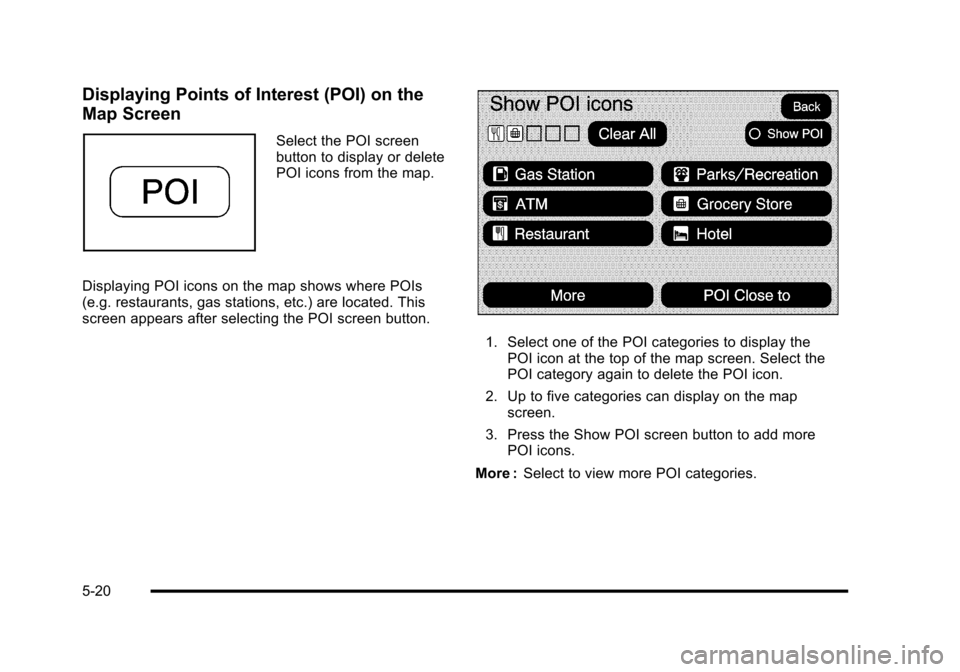
Displaying Points of Interest (POI) on the
Map Screen
Select the POI screenbutton to display or deletePOI icons from the map.
Displaying POI icons on the map shows where POIs(e.g. restaurants, gas stations, etc.) are located. Thisscreen appears after selecting the POI screen button.
1. Select one of the POI categories to display thePOI icon at the top of the map screen. Select thePOI category again to delete the POI icon.
2. Up to five categories can display on the mapscreen.
3. Press the Show POI screen button to add morePOI icons.
More :Select to view more POI categories.
5-20
Page 321 of 616

POI Close to:
1. Once a category has been selected, touch thisbutton to display the list of available POIs for theselected POI category. The list provides the POIicon, the name, the direction, and the distance tothe POI from the vehicle's current position.
2. Use the scroll arrows to move up and down the list.
3. Use the sorting screen buttons: Dist (distance),Icon, Name, and on Route as needed.
Go :Select this screen button, next to the desired POI,to make this POI a destination or a stopover.
Select a POI name to receive information about thePOI. From this screen you can select: Address Book,Go, Map, or Call (if Bluetooth®or OnStar®personalcalling is activated).
Address Book :Press to add this POI to the addressbook. See“Nav”underConfigure Menuon page 5!42for information on editing address book entries.
Go :Select to make this POI a destination or astopover.
Map :Select to display the map showing the location ofthe POI.
Call :Select to dial the phone number using yourBluetooth®phone (if“paired”with the vehicle) or theOnStar HandsFree Calling system. For moreinformation about Bluetooth calling, seeBluetooth®onpage 4!67. For more information about OnStarHandsFree calling, see the OnStar Owner Guide.
OK :Select to display the map screen.
Show POI :Select to display or remove the POI iconsfrom the map screen.
List all Categories :Select to list all POIs sortedalphabetically.
Delete :To delete a specific POI category, select thecategory.
Clear All :Select this screen button to clear all selectedPOI categories.
5-21
Page 322 of 616
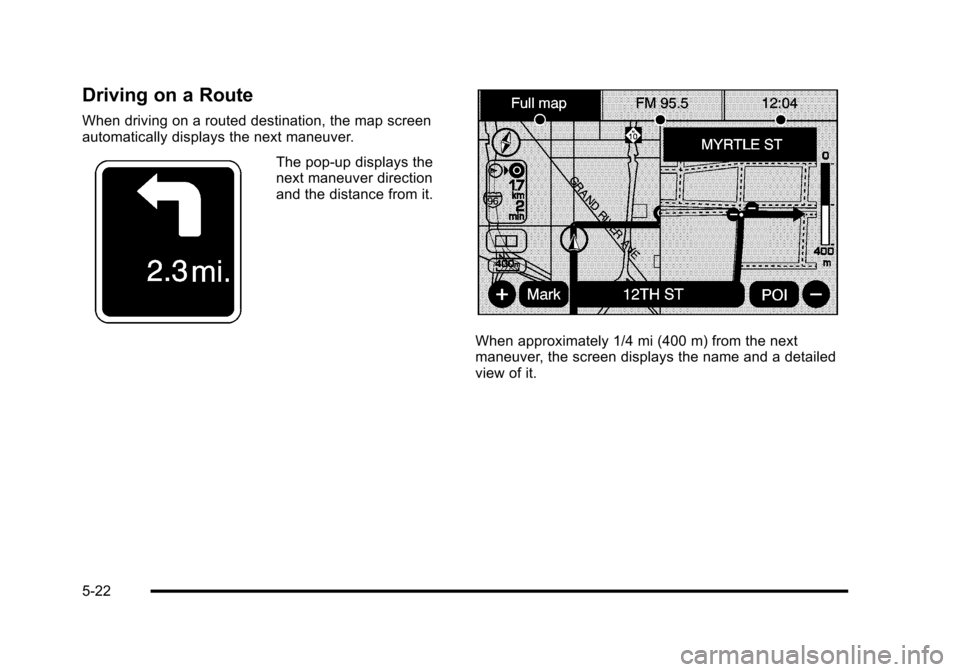
Driving on a Route
When driving on a routed destination, the map screenautomatically displays the next maneuver.
The pop-up displays thenext maneuver directionand the distance from it.
When approximately 1/4 mi (400 m) from the nextmaneuver, the screen displays the name and a detailedview of it.
5-22
Page 323 of 616
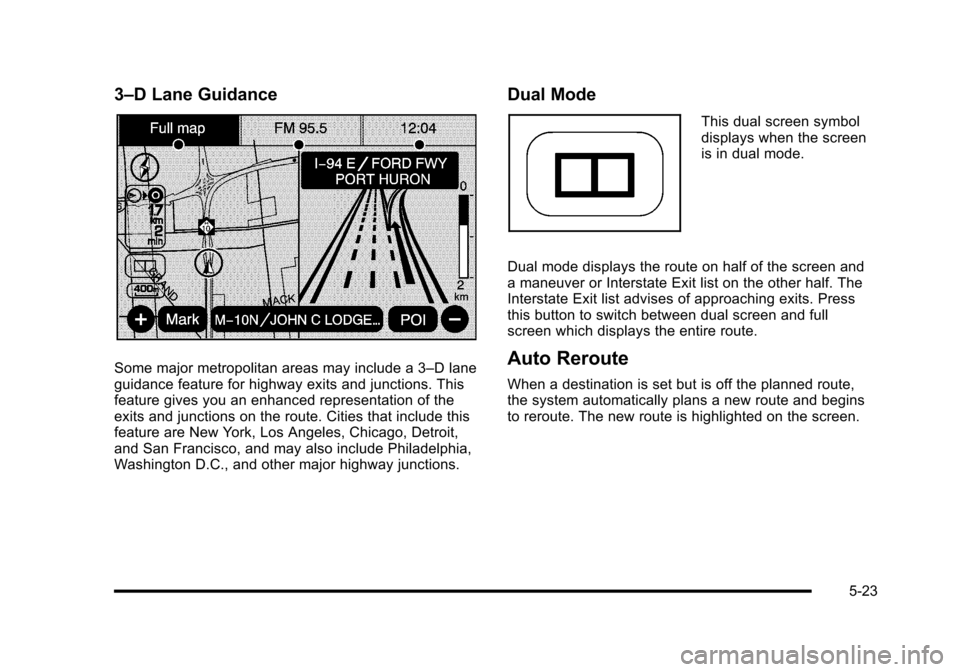
3–D Lane Guidance
Some major metropolitan areas may include a 3–D laneguidance feature for highway exits and junctions. Thisfeature gives you an enhanced representation of theexits and junctions on the route. Cities that include thisfeature are New York, Los Angeles, Chicago, Detroit,and San Francisco, and may also include Philadelphia,Washington D.C., and other major highway junctions.
Dual Mode
This dual screen symboldisplays when the screenis in dual mode.
Dual mode displays the route on half of the screen anda maneuver or Interstate Exit list on the other half. TheInterstate Exit list advises of approaching exits. Pressthis button to switch between dual screen and fullscreen which displays the entire route.
Auto Reroute
When a destination is set but is off the planned route,the system automatically plans a new route and beginsto reroute. The new route is highlighted on the screen.
5-23
Page 325 of 616

4. Once a state or province has been selectedthe City name category is automatically selectedfor entry.
Enter the City Name or touch the Last 5 Citiesscreen button.
The Last 5 Cities screen displays a list of the lastfive city names that had been entered. Select a cityfrom the list and it appears in the City name area.
If using the alpha keyboard, finish entering the cityname. If five or less names are available, a listdisplays. If more than five are available, the Listscreen button displays a number. This numberrepresents the number of available cities. Selectthis button to view the list and select a city.
5. Once a city has been selected the Street namecategory is automatically selected for entry.
Start entering the street name. If five or less namesare available, a list displays. If more than five areavailable, the List screen button displays anumber. This number represents the number ofavailable streets. Select this button to view the list.
6. Once a street has been selected, press theHouse # screen button to enter the house number.The system displays the house number range thatis available for the street.
7. Select the Go screen button. The map screen, withthe destination marked displays.
8. Select the route preference (Fastest, Shortest,or Other). The system calculates and highlightsthe route.
9. Select the Start Guidance screen button. The routeis now ready to be started.
See“Getting Started on Your Route”later in thissection for more information.
To enter a destination by entering the street name first:
1. Press the DEST hard key.
2. Select the2screen button.
3. Select the state/province screen button, if needed,to change the current state or province. A list of allof the available states and provinces appear.Select the state or province.
5-25
Page 326 of 616
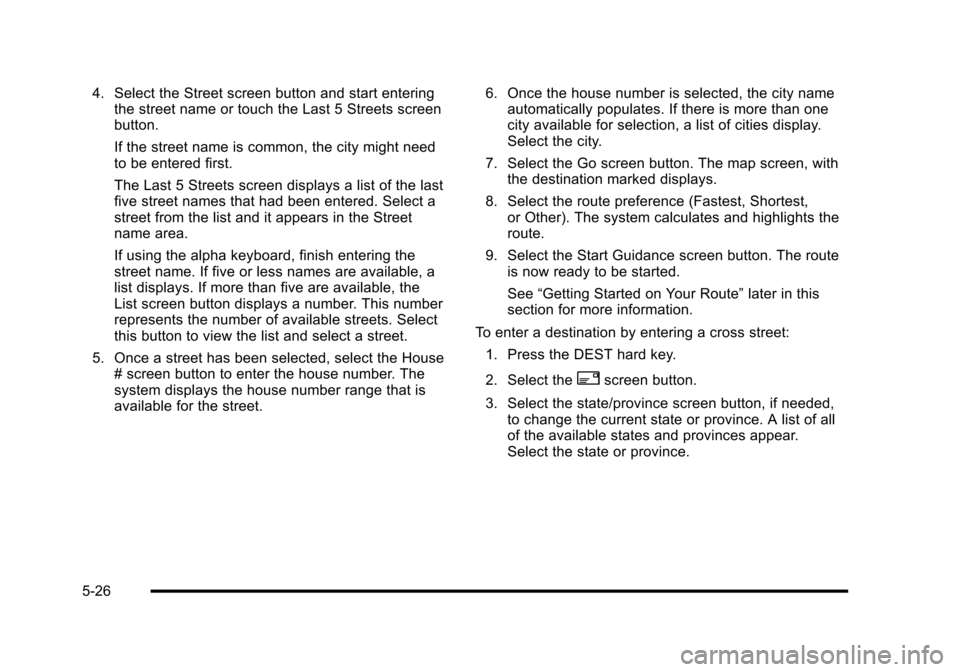
4. Select the Street screen button and start enteringthe street name or touch the Last 5 Streets screenbutton.
If the street name is common, the city might needto be entered first.
The Last 5 Streets screen displays a list of the lastfive street names that had been entered. Select astreet from the list and it appears in the Streetname area.
If using the alpha keyboard, finish entering thestreet name. If five or less names are available, alist displays. If more than five are available, theList screen button displays a number. This numberrepresents the number of available streets. Selectthis button to view the list and select a street.
5. Once a street has been selected, select the House# screen button to enter the house number. Thesystem displays the house number range that isavailable for the street.
6. Once the house number is selected, the city nameautomatically populates. If there is more than onecity available for selection, a list of cities display.Select the city.
7. Select the Go screen button. The map screen, withthe destination marked displays.
8. Select the route preference (Fastest, Shortest,or Other). The system calculates and highlights theroute.
9. Select the Start Guidance screen button. The routeis now ready to be started.
See“Getting Started on Your Route”later in thissection for more information.
To enter a destination by entering a cross street:
1. Press the DEST hard key.
2. Select the2screen button.
3. Select the state/province screen button, if needed,to change the current state or province. A list of allof the available states and provinces appear.Select the state or province.
5-26
Page 327 of 616
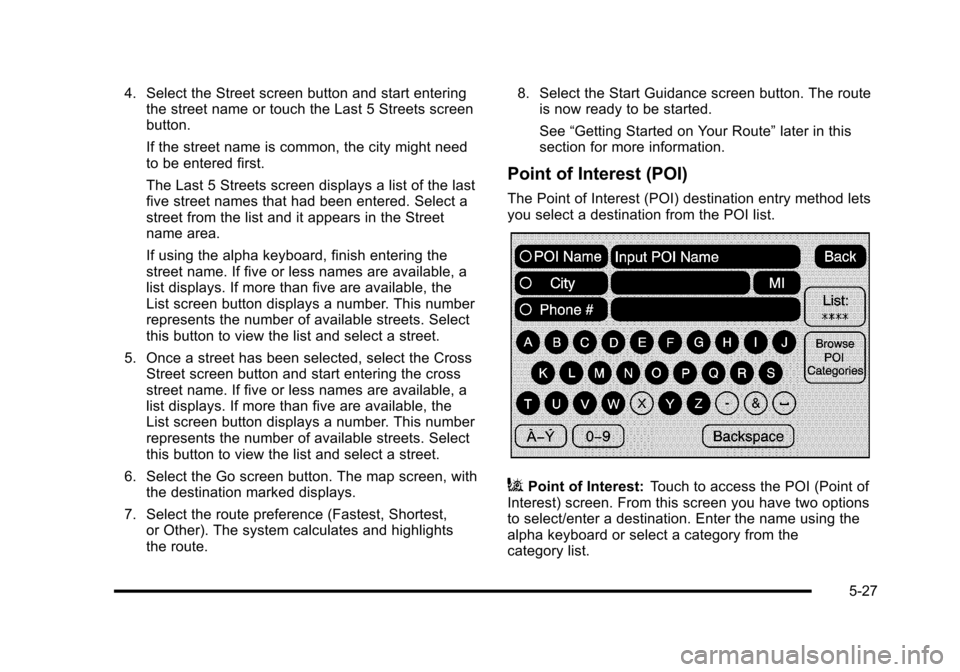
4. Select the Street screen button and start enteringthe street name or touch the Last 5 Streets screenbutton.
If the street name is common, the city might needto be entered first.
The Last 5 Streets screen displays a list of the lastfive street names that had been entered. Select astreet from the list and it appears in the Streetname area.
If using the alpha keyboard, finish entering thestreet name. If five or less names are available, alist displays. If more than five are available, theList screen button displays a number. This numberrepresents the number of available streets. Selectthis button to view the list and select a street.
5. Once a street has been selected, select the CrossStreet screen button and start entering the crossstreet name. If five or less names are available, alist displays. If more than five are available, theList screen button displays a number. This numberrepresents the number of available streets. Selectthis button to view the list and select a street.
6. Select the Go screen button. The map screen, withthe destination marked displays.
7. Select the route preference (Fastest, Shortest,or Other). The system calculates and highlightsthe route.
8. Select the Start Guidance screen button. The routeis now ready to be started.
See“Getting Started on Your Route”later in thissection for more information.
Point of Interest (POI)
The Point of Interest (POI) destination entry method letsyou select a destination from the POI list.
iPoint of Interest:Touch to access the POI (Point ofInterest) screen. From this screen you have two optionsto select/enter a destination. Enter the name using thealpha keyboard or select a category from thecategory list.
5-27
Page 328 of 616

To use the point of interest destination entry method byentering the name:
1. Press the DEST hard key.
2. Select theiscreen button.
3. Select the state/province screen button, if needed,to change the current state or province. A list of allof the available states and provinces appear.Select the state or province.
4. Enter the POI name.
If five or less names are available, a list displays.If more than five are available, the List screenbutton displays a number. This number representsthe number of available POIs. Select this button toview the list.
5. Select the Go screen button next to the POI. Themap screen, with the destination marked displays.
6. Select the route preference (Fastest, Shortest,or Other). The system calculates and highlights theroute.
7. Select the Start Guidance screen button. The routeis now ready to be started.
See“Getting Started on Your Route”later in thissection for more information.
To use the point of interest destination entry method byselecting a category:
1. Press the DEST hard key.
2. Select theiscreen button.
3. Select the Browse POI Categories screen button toview the list of POI categories.
4. Select a category.
The system displays available POI names in theselected category.
5. Select the Go screen button next to the POI. Themap screen, with the destination marked displays.
6. Select the route preference (Fastest, Shortest,or Other). The system calculates and highlightsthe route.
7. Select the Start Guidance screen button. The routeis now ready to be started.
See“Getting Started on Your Route”later in thissection for more information.
5-28
Page 329 of 616
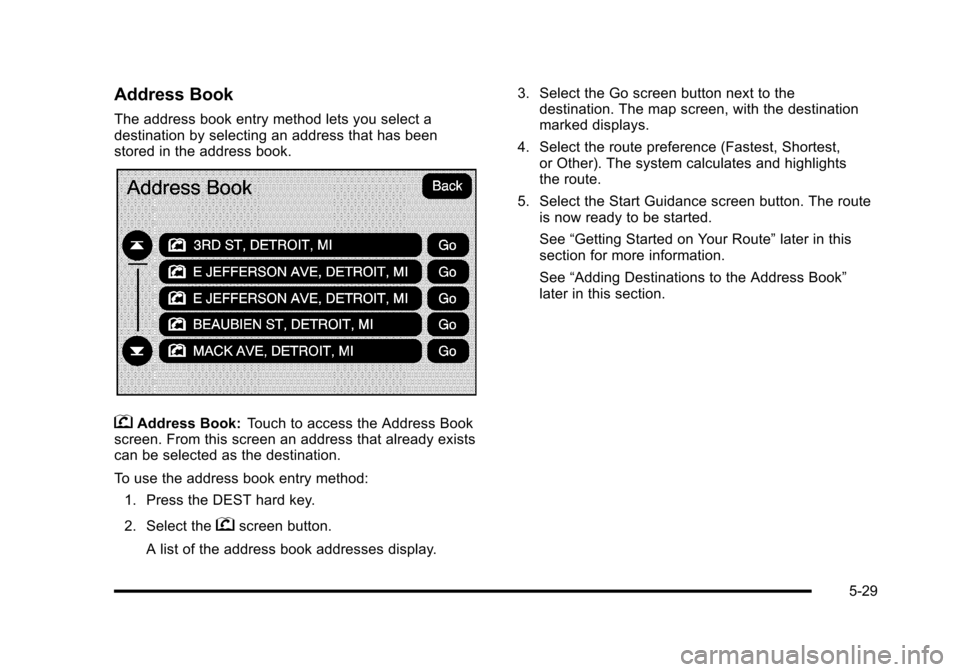
Address Book
The address book entry method lets you select adestination by selecting an address that has beenstored in the address book.
gAddress Book:Touch to access the Address Bookscreen. From this screen an address that already existscan be selected as the destination.
To use the address book entry method:
1. Press the DEST hard key.
2. Select thegscreen button.
A list of the address book addresses display.
3. Select the Go screen button next to thedestination. The map screen, with the destinationmarked displays.
4. Select the route preference (Fastest, Shortest,or Other). The system calculates and highlightsthe route.
5. Select the Start Guidance screen button. The routeis now ready to be started.
See“Getting Started on Your Route”later in thissection for more information.
See“Adding Destinations to the Address Book”later in this section.
5-29
Page 330 of 616

Previous Destination
The previous destination entry method lets you select adestination from a list of previous destination points.
/Previous Destination:Touch to access the PreviousDestination screen. The system stores up to 20 pointsthat have been previously entered. As new destinationsare entered, the system automatically deletes the oldestdestinations and adds the new destinations.
To use the previous destination entry method:
1. Press the DEST hard key.
2. Select the/screen button.
3. Select a previous destination from the list. Use thearrow to the right of the destination to view theentire destination name as necessary. Use thescroll arrows to the left to scroll through the list.
4. Select the Go screen button next to thedestination. The map screen, with the destinationmarked displays.
5. Select the route preference (Fastest, Shortest,or Other). The system calculates and highlightsthe route.
6. Select the Start Guidance screen button. The routeis now ready to be started.
See“Getting Started on Your Route”later in thissection for more information.
5-30